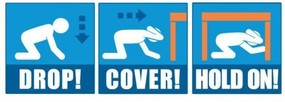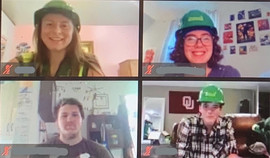|

Practice Earthquake Drills with the Great ShakeOut
Earthquakes can occur anytime and anywhere without warning. Now is a perfect time to practice earthquake safety. To help you prepare, one easy and safe step is to participate in the Great ShakeOut earthquake drill on October 15, 2020. Each year, on the third Thursday of October, millions of people participate to learn how to stay safe during earthquakes. Register here to join the event!
While learning to stay safe and prepare for earthquakes amid COVID-19, please follow the latest guidance from the Centers for Disease Control and Prevention (CDC).
Below are steps to help you prepare for earthquakes while staying safe during COVID-19:
- Practice the drop, cover, and hold on steps with your family and coworkers.
- Ensure items such as televisions and objects that hang on the walls are secured and store heavy and breakable objects on low shelves.
- Create an emergency plan with the whole family and practice it regularly. This should include what is needed to protect you and your family from an earthquake and other disasters, including COVID-19.
- Build an emergency kit that includes essential items such as water, non-perishable food, and prescription medicines for at least three days for the whole family, including pets; and a flashlight, a fire extinguisher, and a whistle.
- Consider obtaining an earthquake insurance policy. A standard homeowner’s insurance policy does not cover earthquake damage.
- Consider fixing structural issues that could cause your building to collapse during an earthquake.
Please visit www.ready.gov/earthquakes to learn more about what to do before, during, and after an earthquake.
Are You Prepared for a Wildfire?
Emergency plans are vital to ensuring your health and safety in wildfire areas. Only 29% of people living in wildfire areas have emergency plans that include how to evacuate. While we are enduring the COVID-19 pandemic, the most important protective action for a wildfire is evacuation. When planning, review multiple evacuation routes from locations you and your family frequent as this can be an important factor in surviving a wildfire. Due to COVID-19, public evacuation shelters may not be the safest choice for you and your family. Have you made plans to shelter with friends or family? Emergency plans should include locations for you and your family to shelter and stay safe.
The pandemic has caused serious supply shortages across the country, including N-95 masks. This means that people living in wildfire risk areas should make plans to protect themselves and limit smoke exposure by evacuating early. If you do need to evacuate, having supplies already packed and ready to go can help you evacuate more quickly. Only 52% of those living in wildfire areas have supplies already packed and ready to go. Are you prepared to evacuate?
Learn more about wildfire preparedness at and how the public is preparing for disasters by checking out the following resources:
|
|
|

FEMA Launches New National CERT Website
You spoke; we listened! Community Emergency Response Team (CERT) leaders across the country can now use a new and improved registration site! New user-friendly features and a re-designed format mean an easier and more effective experience for all users. Whether you are a State/Regional coordinator or a new CERT user, the new site streamlines all your needs in one central location.
CERT Coordinators can now:
- Manage, approve, and search within each log-in profile using the new CERT Coordinator Dashboard
- Access the CERT Program Metrics dashboard for real-time program data
- Utilize the new “Search this list” feature for a Contact Directory and CERT Registry
CERT Users now have access to:
- Take the Annual CERT Survey
- Log new Preparedness Activities
- Update CERT Program profiles
Existing users can log in and try out the new site now. Have a question about the site? Email FEMA-Prepare@fema.dhs.gov. Stay tuned for more information about webinars to help navigate the new site.
|

New Jersey Teen Launches a CERT
Just after she turned 9, Hurricane Sandy hit Allison Fung’s hometown of Hoboken, NJ.
“The day after, the streets were so deep in water that cars were totally submerged. Basements were filled with sewage water. We had no power. It was cold and dark in the house with nothing to do, but we had it lucky compared to others,” she recalls of the 2012 storm. Her family jumped in to help and when Fung distributed food and supplies to those in need. “I felt some control over this disaster and like I was doing something to help the community,” she recalls. Following that experience, her parents decided to become CERT volunteers.
Fast forward to 2020. Not only has Fung herself been a CERT volunteer for two years, she helped start a Teen CERT in Hoboken. Read more...
|

Helping CBOs Understand Potential Risks
The first step in preparing is understanding what hazards your community-based organization (CBO) might face. Whether you’re a nonprofit, faith-based group, or small business, knowing your risks is key. Often this depends on where you’re located: those affected by hurricanes, for example, may have to shore up their buildings to withstand strong winds and plan for evacuations. Those affected by severe winter weather must be ready to figure out how to help their clients if a blizzard closes down streets and cuts power. A variety of different hazards come with different needs to prepare.
Being prepared was highlighted recently for employees at Vintage, a CBO which serves senior citizens in five mountainous Colorado counties. That area often faces blizzards, wildfires, and floods. In August, flames tore through tens of thousands of acres due to several wildfires in the area. Read more...
|
|
|
CBO OPEN Training
On September 17, 2020, FEMA held a webinar to discuss the new Organizations Preparing for Emergency Needs (OPEN) training, and how it will help Community-Based Organizations (CBOs) prepare for incidents and continue providing services after a disaster. Click here to view the recorded session.
|
ICYMI: Webinars—2020 National Household Survey Findings
In case you missed them, the two-part webinar series on the findings from the 2020 National Household Survey (NHS) were recorded and posted online:
For Part I, click here.
For Part II, click here.
|
|

Kid’s Korner: New York City Selects its First Youth Commissioner for a Day
What’s it like to oversee the emergency management activities for the country’s largest city? High school student Katerina Corr was curious. So, she entered—and won—New York City’s first “Commissioner for a Day” essay contest to find out.
Corr, who finished her two-year term in FEMA’s Youth Preparedness Council (YPC) earlier this year, has long been interested in emergency preparedness. “I’m excited about NYC emergency management [and] how it’s such a big city with so many groups collaborating,” she says.
The event, originally scheduled for March, was postponed due to COVID-19. As a follow-up, Corr attended a virtual commission meeting in June, where city officials recognized her for being the first Youth Commissioner for a Day.
During the virtual meeting, Corr said she was particularly impressed by Deanne B. Criswell, Commissioner of the New York City Emergency Management Department. “I was very much inspired by Commissioner Criswell’s dedication to preparedness and her breadth of experience in homeland security and emergency response,” Corr says. “Although I am no longer a member of the National YPC, this attitude will continue to inspire my engagement in community emergency preparedness and my college education.”
Corr asked what effect COVID-19 will have toward attitudes on emergency planning in the future during the meeting. “Overall, I think the pandemic has taught me how many different stakeholders are involved in emergency response,” she says. “Between agencies, non-government organizations, elected officials, and health experts, there are many different voices playing a part. Seeing how these different groups have coordinated has been very interesting.”
To learn more about how youth can participate in preparedness, please visit https://www.ready.gov/kids.
|
|
|
 Youth Prepare in the Pacific Northwest
In an exciting virtual event hosted by FEMA Region X, 35 teens took part in an interactive Youth Preparedness Workshop in July. Chosen from more than 550 applicants across Alaska, Idaho, Oregon, and Washington, the young leaders attended the three-day workshop to learn Community Emergency Response Team (CERT) basics. Read more...
|
Improving Youth Preparedness Programs through Research
In mid-year 2020, FEMA performed research on youth preparedness education and training. The goal was to gain insight on how to strengthen and best use methods that prepare youth for disasters. FEMA found that there is a need to use inclusive, adaptable, and flexible materials when teaching youth about preparedness. These materials must ensure that the needs of youth with and without access and functional needs (e.g. youth with and without disabilities, different types of learning abilities, and low vision) are met equally. The data also revealed that the materials should be enticing and interactive. Read more...
|
|
National Savings Day is Monday, October 12
In honor of National Savings Day on October 12th, FEMA is highlighting its partnerships with America Saves and Military Saves. Both are campaigns managed by the nonprofit Consumer Federation of America, which helps low to moderate-income households learn how to save, budget and reduce debt, all key elements of financial resilience. America Saves’ resources include information on how to set financial goals and make plans, as well as tips on automating savings and getting out of debt. Military Saves’ similar resources are tailored for service members and their families.
America Saves and Military Saves will hold a series of three virtual town halls called #ThinkLikeASaver this fall. These two-hour Facebook events with financial experts will be held from 2 to 4 p.m. Eastern Time on the following Thursdays:
- Oct. 22nd: Simple Strategies to Help You Save
- Nov. 5th: How Do I Pay Off Debt?
- Nov. 19th: Saving for Major Life Milestones
Read more...
|
|
Financial Resilience: Tools for Your Community
On September 16, 2020, FEMA held a webinar that discussed the importance of financial preparedness for emergencies. Experts from the Federal Deposit Insurance Corporation (FDIC) and the Consumer Financial Protection Bureau (CFPB) provided real-world examples and talked about tools that can help individuals and communities be more financially prepared. If you would like copies of the materials from this webinar, please email us at FEMA-Prepare@fema.dhs.gov.
|
Preparing for the True Cost of Floods and Other Natural Disasters
On September 3, 2020, FEMA’s National Flood Insurance Program presented on a webinar entitled “Preparing for the True Cost of Floods and Other Natural Disasters” hosted by the Association for Financial Counseling and Planning Education (AFCPE). This webinar gave financial counselors resources to help those they serve better prepare for and recover from natural disasters including floods. To view the recorded session, please click here.
|
|
|
Disclaimer: The reader recognizes that the federal government provides links and informational data on various disaster preparedness resources and events and does not endorse any non-federal events, entities, organizations, services, or products. Please let us know about other events and services for individual and community preparedness that could be included in future newsletters by contacting
FEMA-prepare@fema.dhs.gov.
|
|
|
|
|